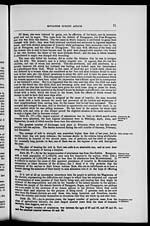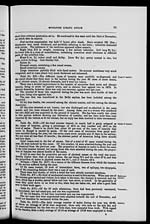Medicine - Mental health > 1867-1924 - Annual report of the insane asylums in Bengal > Insane asylums in Bengal annual reports 1867-1875 > Annual report on the insane asylums in Bengal for the year 1873
(750) Page 72
Download files
Individual page:
Thumbnail gallery: Grid view | List view

72 REPORT ON THE
The highest percentage of cures was also during the same decades as admissions, and the
greatest mortality occurred between 30 and 40.
Duration of disease
prior to admission.
Table No. VIII.—Of the 27 male lunatics admitted during the year, in 18 the duration of
insanity previous to admission was under one year; in 6 it was under five years, and in 3
it was above five years. Of the 14 females, 10 had been insane under one year, and 4 under
five years. Thus in every case admitted was the duration correctly ascertained. Of the 27
male admissions, 5 were cured within 12 months from the date of attack, and 4 were
improved; of the 14 females only one was cured, between the first and second years of the
attack.
Average period of
residence.
Table No. IX.—The average period of residence of each inmate was 525.5 days, being
18.5 days less than that of last year.
Of the 18 cures, 17 were effected within one year of admission, and one between the
fifth and tenth years.
Of the nine improved, seven were discharged within the first year of admission, and two
between the first and second year. It will be remarked that the percentage of the cured
and improved from six to twelve months was considerably higher than that of the last year.
It may here be mentioned that among the nine improved is included the man who was
transferred to the Delhi insane asylum.
Of the four deaths that occurred during the year, one took place within three months of
residence, two between the sixth and twelfth month, and one between the first and second year.
The average period of residence of those who died was 265.5 days.
State of health on
admission.
Table No. X.—Of the 41 admissions, 11 were in good, 18 in indifferent, and 12 in bad
health.
Of the 41 admitted, six were discharged cured during the year, three improved and were
made over to their friends, and one transferred to the Delhi insane asylum. There was no
death among the admitted.
Of the 27 inmates who were discharged, 22 were in good health, 4 in indifferent, and
1 in bad health; and thus it appears that those who went in good health gained in weight,
the one in bad health lost, and those who were in indifferent health neither lost nor gained.
Hitherto the inmates of the asylum were weighed on admission and discharge at the jail at
Moydapore, the two institutions having been close to each other; but the jail has been
removed to Berhampore, and we have no means at our disposal at present of weighing the
lunatics. I would therefore beg to submit the suggestion that the asylum be furnished with
a good weighing machine.
Causes of
mortality.
Table No. XI.—Of the four deaths that occurred during the year, the first was caused by
paralysis. The man was admitted in bad health with chronic dementia, and seven months
after his admission he had an attack of paralysis, which set in without any warning, and
from that time he began to get worse and worse, and died twenty-one days after the seizure,
or nine months and eight days after admission.
The next was a female, who had also been admitted with chronic dementia, but in good
health. About eight months after her admission an inflammatory swelling was observed on her
left ankle, the next day the swelling and redness increased and extended to the leg and thigh,
and in a short time the whole of the inflamed surface became covered with large blisters,
which burst and left a raw surface, which healed in no time. Subsequently blistered spots
appeared in other parts of her body where no inflammatory action of any kind was going on.
The progress of these events was attended with great prostration and exhaustion, and the
woman began to sink gradually, and eventually died six days after the attack. Post mortem
examination was conducted by Dr. Coates, who attributed cause of death to atrophy of the
brain.
The next case was admitted in bad health for chronic mania on the 14th of December
1872. On the 24th of January following he was attacked with fever accompanied with a
bad cough and pain in the chest, as well as in some of the large joints ; the pain soon extended
to other joints, and subsequently took possession of the whole frame, and he seemed as though
he was paralyzed. Notwithstanding every treatment he got steadily worse, and died on the 26th
of February. Post mortem examination showed a large spot of gangrene in the centre of the
left lung, and the right lung hepatized and adhering to the ribs. Death was attributed to
gangrene of the lung.
The fourth and last case was likewise admitted in a very bad state of health for chronic
mania on the 21st September 1872. When admitted he was so emaciated that he weighed
only 35 seers. He continued in that state a short time and then began to improve, and in
April following, i.e. seven months after his admission, he was again weighed, when it was
found that he had gained 12 seers in weight. With the physical improvement he began to
have fits of violent excitement, during which he would seize a kodalee and work with such
energy and activity that, if allowed, he would do in a few hours as much work as is generally
done by others in two days.
Towards the end of November he was taken ill with fever and cough, and complained of
pain in his chest, and soon after dysentery supervened. He was immediately placed under
treatment, but his illness continued unabated, and he began to fall off very rapidly, and in a
Set display mode to: Large image | Zoom image | Transcription
Images and transcriptions on this page, including medium image downloads, may be used under the Creative Commons Attribution 4.0 International Licence unless otherwise stated. ![]()
| Permanent URL | https://digital.nls.uk/83380250 |
|---|




